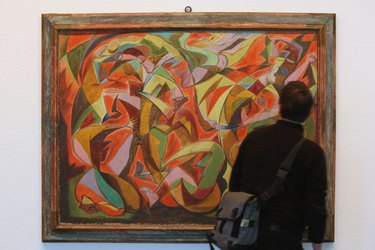
Expressionism is an artistic style that began in post-World War II America and continued through the 1960s. It is the style that put New York City on the map as the center of the art world, and was seen as a backlash to the McCarthyism of the 1950s. Expressionism exists in all forms of art, including painting, sculpture, music, film and drama. Expressionism is any art form that takes an objective observation and creates an experience that is subjective to the viewer or listener.
Basics
Video of the Day
Expressionism explores both the spiritual and unconscious mind. It explores the emotions of the human psyche, without root in reality. While artists use different techniques within expressionism, there are no rules. Expressionism is free form art that allows the artist to explore and interpret his emotions freely. Color and shape are a large part of expressionism. The rules of reality are bent and colors and shapes are utilized to express emotion.
Video of the Day
Painting
Artists use many techniques to create an expressionist painting. Techniques include action painting, which is most famously exemplified by Jackson Pollock. Action painting takes advantage of quick, spontaneous, emotional movements when applying paint to the canvas. Colorfield painting creates distinct areas of color on the canvas. The color appears to blend into the canvas, with color itself being the subject. Hard-edge painting is a technique that uses abstract geometric shapes with strongly defined borders. Expressionist painters also use a variety of tools to apply paint, including sticks, spoons, knives, brushes, bottle caps or string.
Sculpture
Expressionist techniques in sculpture revolve around exaggeration. Sculptors will emphasize various prominent features of the subject rather than sculpting the full physical form, making expressionist sculptures more representational than realistic. The sculptor will distort and elongate her works, creating distorted forms. Expressionist sculpture is meant to reflect the emotional and mental state of the subjects.
Music
Expressionist musicians throw away all conventional ideas and techniques when they create music. Instead, they incorporate dissonant chords and atonal melodies to create music that evokes dark and bitter emotions. Expressionist techniques in music are open to the artist's interpretation, although expressionist music is rarely considered pretty or melodic.
Film and Theater
Expressionism in movies and theater is designed to illicit an emotional response from the audience. Directors will incorporate techniques that play on light, camera angles and the contrast of shapes and shadows. In film, directors will use a technique called depth setting, in which the background becomes the foreground in the shot. In film and theater, the actor's costumes may match or directly oppose the style or colors of the set. On the stage, the set may be painted to look like an expressionist painting. The plot of the film or stage show may be difficult to pinpoint, as expressionism in film and theater is usually obscure.